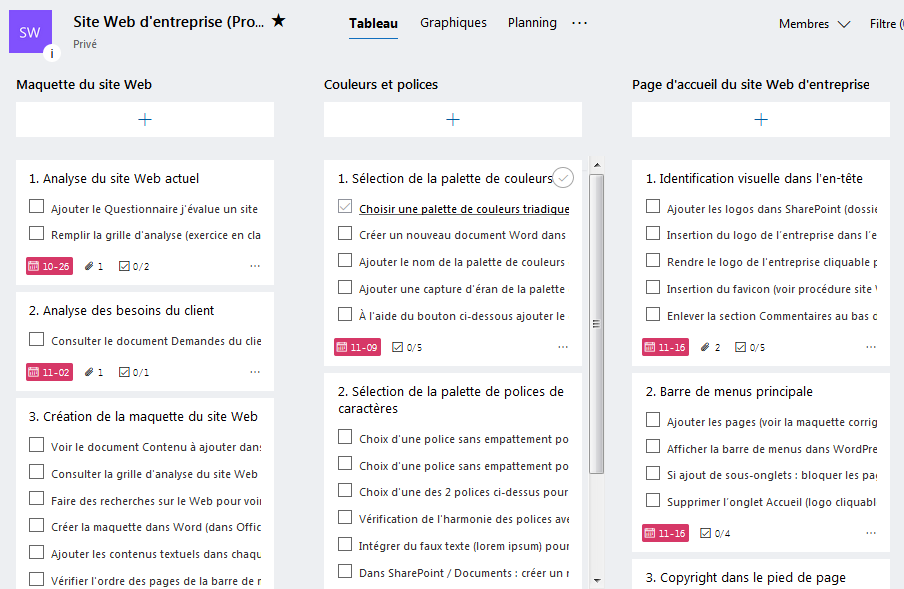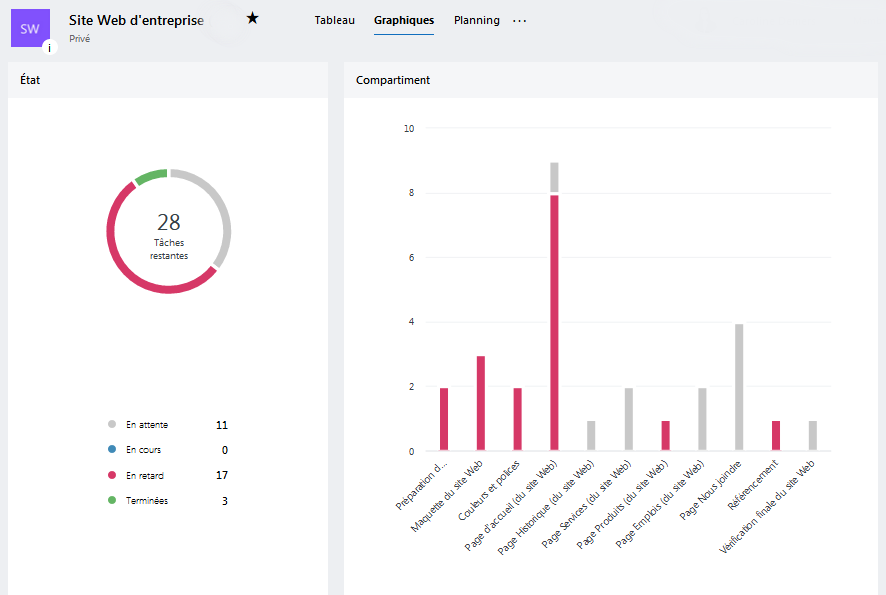Planner (Microsoft Office 365): A Tool That Simplifies Task Organization, Time Management, and Collaborative Work
For both teachers and students, work organization can be a challenge for a number of reasons: scheduling tasks, estimating deadlines, managing documents, obtaining follow-ups when working as part of a team, revising schedules for delays and unforeseen events, etc. To simplify the management of work and assignments, Planner, a task scheduler included in the Office 365 Suite, becomes extremely efficient when combined with the Outlook calendar.
Effectively Managing Daily Work
In my opinion, Planner could easily replace the “Tasks” module of Outlook. It is a perfect combination of Trello and Microsoft Project. Planner facilitates the organization of work by providing a pleasant environment integrating the list of tasks to be done for projects (called Plans) and their deadlines. These tasks can be divided into categories (called Buckets).
By entering the completion period of each task bucket, Planner can automate the operations (deadlines and reminders) that users would normally enter into their Outlook calendar later. As Planner can export the tasks and deadlines to the Outlook calendar, it becomes possible to work with only one tool. When a task is due, Outlook automatically sends a reminder a few days before and other reminders when the time is up. Updates in Outlook and in Planner are synchronized.
An Essential Tool for Collaboration
Planner provides an extremely collaborative environment for working effectively as a team. When creating a plan, it is possible to invite other colleagues to participate in order to assign them tasks and deadlines to respect. Then, the team leader can export everyone’s tasks and deadlines to their respective Outlook calendar. Different types of permissions can be assigned to colleagues: administrator, guest, etc. When an administrator makes a change to a task or due date in Planner or Outlook, all team members receive an automated notification in their inbox. At all times, team members have access to the shared task calendar.
To quickly analyze the progress of work, Planner generates a chart that compiles the number of uncompleted and completed project tasks. The tasks can also be compiled by team member to check if the repartition of tasks is balanced and to see the progress of their respective tasks.
In each bucket, there is an instant messaging space that allows members of the team to communicate with each other, for example to follow up on progress. Each time new content is published, all members receive an email.
When a new plan is shared with colleagues, Planner automatically creates other collaborative spaces in the Office 365 applications below:
- SharePoint (Files option) to host all project files in order to centralize information and work on a single version.
- OneNote (Notebook option) to gather information from meeting discussions (brainstorming, summaries and meeting minutes, audio recordings, etc.) and regroup information from different sources (Word, PDF, Excel, screenshots, etc.). In addition, when copying-pasting from the internet, the sources are automatically integrated as a hyperlink.
- GroupMail (Conversation option) to get an instant messaging module in Outlook in order to start a conversation with other team members.
Team members can also add other apps to Planner, such as Skype for video conferencing.
Integrating Planner in the Classroom
In one of my courses where I use the project-based learning approach, I asked my students to work in teams to design a corporate website over a period of several weeks. For my students to grasp the scope of this project and its complexity, I first set up an exercise in which they analyzed the current website and the client’s needs using an evaluation grid. Thus, they were able to quickly identify all the tasks to be completed. Then, we drew up a list of counterproductive elements related to work organization and coordination, in order to convince the students of the relevance of using Planner, chosen for four reasons:
- I wanted them to develop their work organization skills and to better manage unforeseen events and time in their diary.
- I wanted my students to export their respective tasks to their Outlook calendar so that they could quickly estimate the work to be done each week.
- I also wanted them to regularly see the progress of their work and make the necessary adjustments, especially in the case of delays. I wanted to see them further develop their autonomy and their rigour.
- I already use a OneNote class notebook. I wanted them to stay in the Office 365 environment, so they learn the other features that allow them to work collaboratively and develop an effective work method.
Each team had to appoint a person in charge. Subsequently, they completed a contract where they fairly distributed all project tasks. Once the contract was approved, all the people in charge created a plan, copying the template I made available to them. They then invited their team members to delegate the agreed tasks. I used this strategy for two reasons:
- The start and end dates in each task bucket were already entered because I had synchronized them with the schedule of my lesson plan. Students rescheduled specific tasks when they faced unforeseen events or to have more flexibility.
- Students learned new subject matter every week. They acquired a sense of responsibility and rigour because I asked them to add new tasks to keep their project plan up-to-date based on this new information.
In class, I gave my students about 45 minutes of training on the features of Planner and other shared applications to work collaboratively effectively. The Planner Video Training page on the Microsoft Office website contains a lot of material for autonomous learning.
Using Planner in different contexts
Planner and its other collaborative applications can be used in multiple pedagogical contexts:
- in a project-based learning approach where students must work as a team
- for the acquisition of a skill or course competency related to the organization of work
- for the organization of an extracurricular event
- to simplify the management of client files in a school enterprise
To conclude, several students have mentioned to me that they used Planner to plan the tasks of their other courses. Some people have also informed me that they now use Outlook as their main calendar and diary tool. They have integrated their assignment deadlines, their job schedule, and their other activities and appointments. They have found this to be very beneficial.





